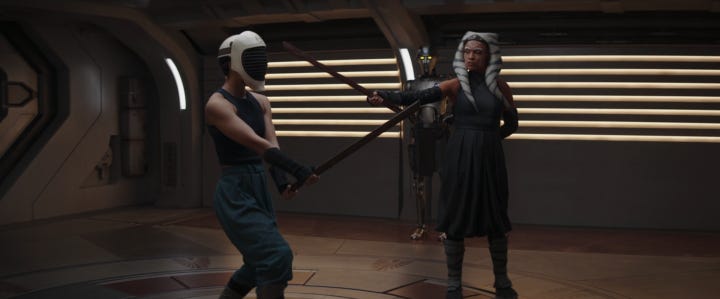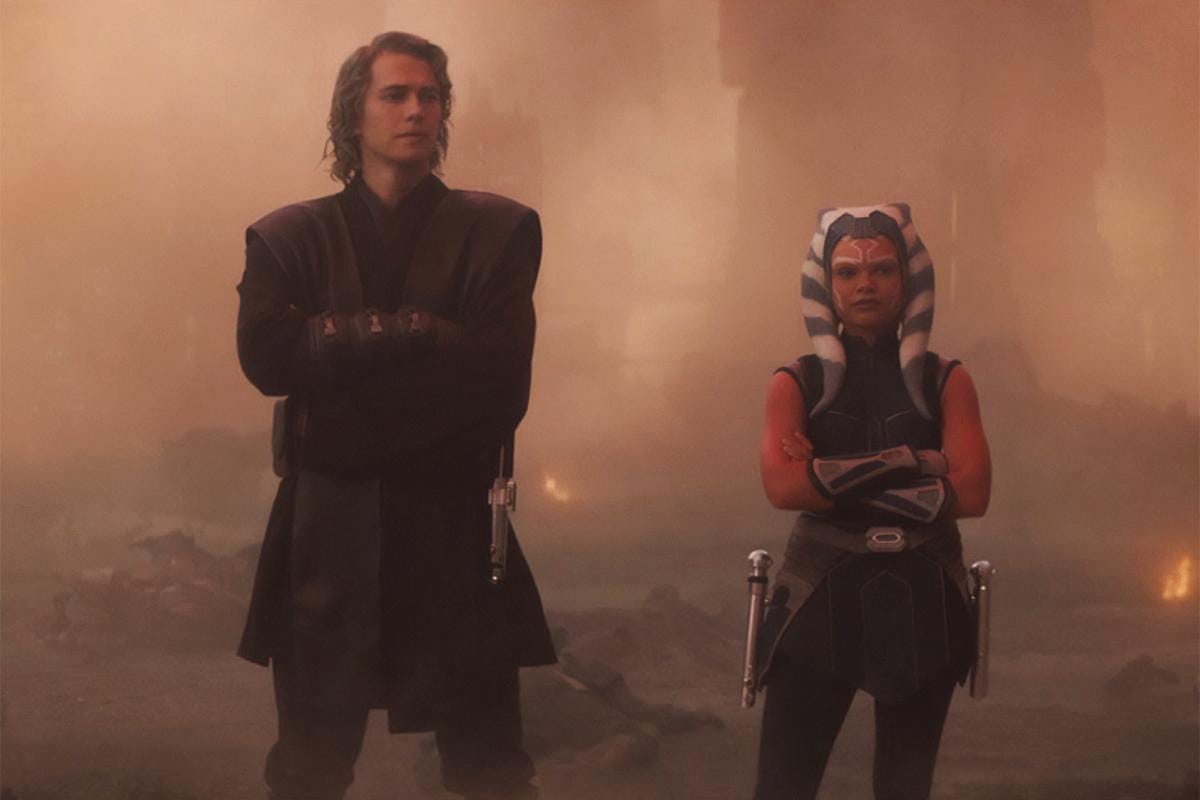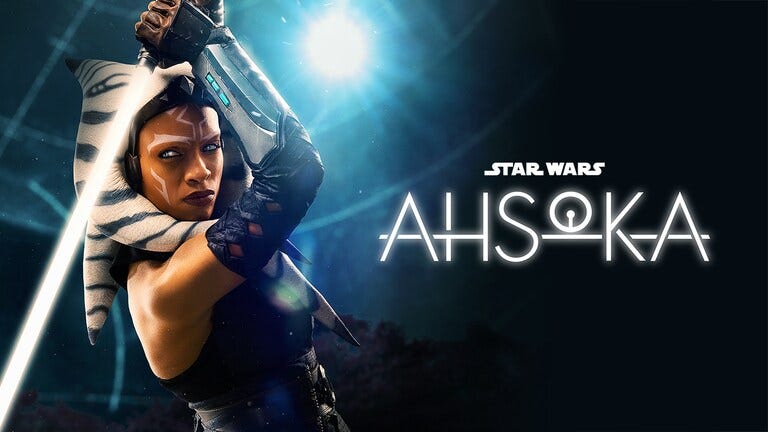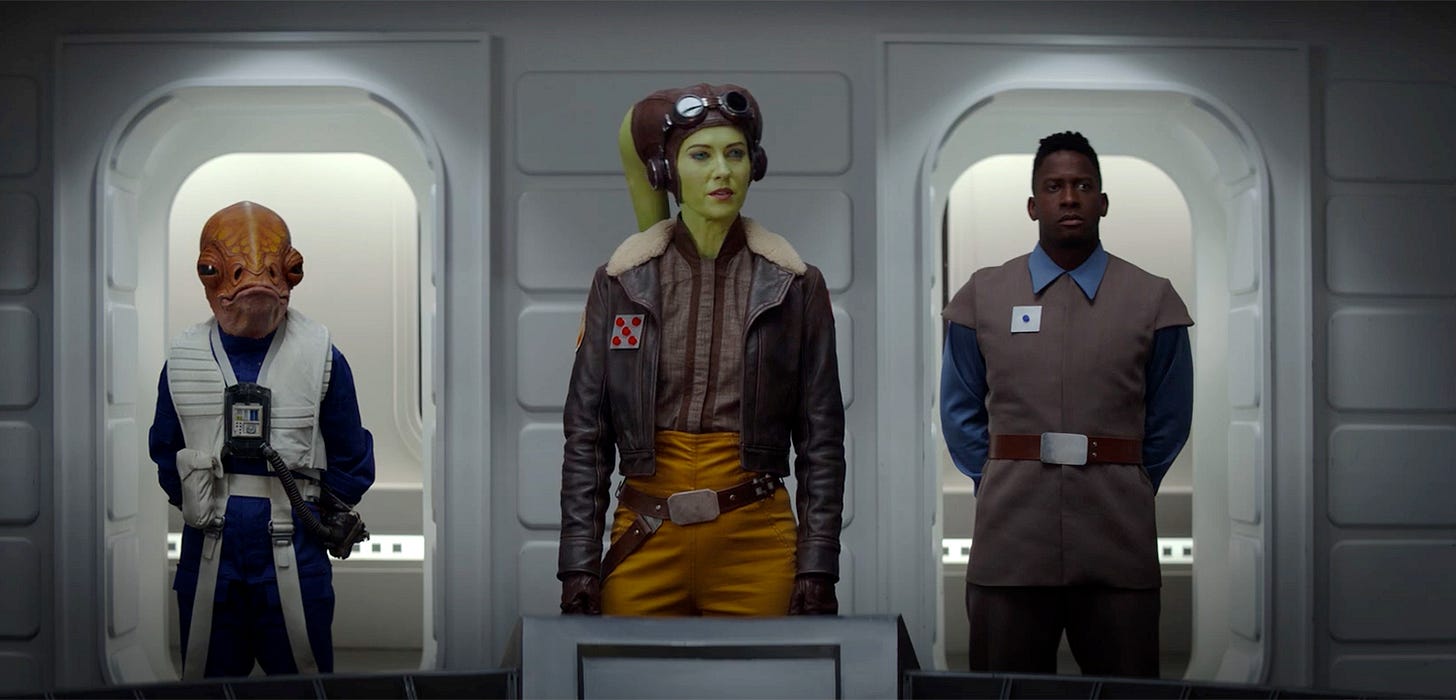In the opening moments of Ahsoka, I knew that the type of Star Wars I love was back, and then some. After starting on an opening crawl, something we haven’t seen since The Rise of Skywalker, with highly ominous music from the brilliant Kiner’s, we bear witness to the thematic antithesis of the opening of The Phantom Menace. A Jedi shuttle boards a New Republic vessel bringing confusion to the crew. The Jedi Order is long gone, so who’s commanding this ship? What follows is similar to A New Hope, two dark force wielders — with red-orange saber blades — infiltrating a ship that possesses something our antagonists want, transitioning into the title card of the series, embellished by a bombastic version of Ahsoka’s theme to usher in a new era for this longstanding character.
If you missed my background on the character, you can read that here.
As a student of George Lucas, series writer and longtime Star Wars creator Dave Filoni trickles homages to all of Lucas’ work throughout this live action season of his own creation, Ahsoka. Most importantly though, he’s able to capture the storytelling structure of the original film again. Star Wars stories have always been told in a way that emphasizes the world we’re visiting is lived in. There’s a history and a legacy to everything, which we obviously don’t see all of, that provides backstory between the lines for characters that range from main roles to just crossing through the background. Way back in 1977, audiences knew nothing about Obi-Wan Kenobi’s past, where he touts the mysterious Clone Wars, but no one questioned it because of how real it felt. Dave Filoni, with help from all of his directors, did a great job, despite so many years since 1977 of Star Wars properties, of keeping perspective, capable of supplying intrigue for newcomers and longtime fans alike.

In the series, Ahsoka Tano is a lone swordsman traveling the galaxy, formerly of the Jedi Order, investigating the possible return of a former threat to the galaxy, the lost Imperial Grand Admiral Thrawn. Needing help, she turns to old friends, Hera Syndulla and Sabine Wren, struggling to reconnect with the latter because of a former, tension filled, bout as master and apprentice. Struggling to rekindle the relationship, Ahsoka must confront her own personal demons if she hopes to succeed against powerful forces that look to undermine her, and her apprentice’s, journey to bring an old friend home while also preventing the return of galactic war.
Despite the title, this is, loosely, structured as a fifth season to Star Wars: Rebels, which teased Ahsoka and Sabine going on a journey to find Ezra in its finale over five years ago now. For some people, none of what I just wrote made any sense. Star Wars animation has been a staple for this franchise’s storytelling for 15 years now, but people haven’t watched any of the shows because of the stigma that animation is for children. While I do feel for people who may be confused going into this series, most Star Wars content under the Disney banner is accessible to new audiences, so it’s nice to let the die hard fans like me have something that’s just for them for once. And like I mentioned earlier it’s still written with everyone in mind, mentioning just enough to entice longtime fans and provide understanding and acceptance to newcomers. And if people still remain confused, they have a ton of television episodes to watch that are readily available.

Ahsoka Tano’s first appearance in live action was in the Mandalorian season 2 chapter entitled ‘The Jedi.’ Rosario Dawson was brilliant in that episode, bringing tears to this fan’s eyes, even upon rewatches. It’s in her own series where she can broaden her interpretation and make it her own compared to the previous voice work from Ashley Eckstein. Donning the practical, Lekku, headpiece and a ton of makeup to give her skin the character’s orange tinge, Dawson visually transforms. But it’s the physicality she pushes herself to provide for the roll that makes the character’s transition from animation to live action nearly one to one.

Lightsaber battles, specifically ones that feature Dawson as Ahsoka, are incredibly choreographed. In all 8 episodes of the season, there’s at least one lightsaber fight in each — the filmmakers making sure the audience knows that Jedi are without a doubt the main focus of this series. All the force wielders in this series have a uniquely different fighting style that makes for the most intriguing lightsaber battles since the days of George Lucas. Every movement, attack, and defense is conducted by the main cast of actors, all challenging one another to not only complete their work correctly, but to also appear as if they actually want to hurt each other, providing a challenge that is less a dance and more an actual fight. It’s uniqueness also stems from Japanese culture and Samurai films, featuring an entire training sequence where music, moves, and attire are all sci-fi interpretations of those Samurai films, like those made by Kurosawa, that inspired the original Star Wars.

On the antagonistic side of these fights comes a gluttony of new characters to the Star Wars universe that are intriguingly written — with certain performances enhancing what is quite minimal on the page. The late Ray Stevenson, who passed away over the summer before the show’s release, portrays the former Jedi and dark side user Baylan Skoll. He is without a doubt the standout of this series, locking myself and many viewers in every time he appeared on screen. His calm demeanor and stimulating aspirations combined with his large build and heavy fighting style craft a character that feels unequivocally original. Skoll is paired with his apprentice, Shin Hati, portrayed by Ivanna Sakhno, whose ferocity and unwavering obedience to her master work as a complimentary opposite to her teacher. Both characters became indisputable scene stealers throughout the season, and work as great foils to Ahsoka and Sabine. While Stevenson is no longer with us, and unfortunately was unable to see the love his performance is garnering, I impatiently await the continuation of these characters’ stories in the future.
Opposite of these new villains, our heroes are new to the space of live action storytelling but, like Ahsoka, have a long history in the animated space. Hera Syndulla, Sabine Wren, and the droids Chopper and Huyang all have previous appearances in the Star Wars universe, including the Jedi Ezra Bridger, whom I mentioned earlier. While it took a second for me to get used to different actors providing the voice for these characters I’ve spent so much time with (other than the droids of course), they all embody the look and spirit of their animated counterparts, making the show feel even more like a continuation of Rebels than I initially thought going in. Sabine Wren, especially, will be a new fan favorite going forward. With cool armor, Mandalorian vigor, and the lesson that being a Jedi comes from dedication and tenacity, not necessarily talent, she’ll without a doubt inspire many fans from here on.

This series also features the long desired live action appearance of Grand Admiral Thrawn. The blue Imperial strategist and war leader, of Chiss descent, first appeared in Timothy Zahn’s Heir to the Empire novel in 1991, marking the first chapter of what used to be considered the sequel trilogy back when there was no new movies on the horizon. As someone who obsessed over Thrawn during his appearance on Rebels, and subsequently read all the canon material released by Zahn under the Disney banner, his portrayal in this was one of the few disappointments I had for the season. Don’t get me wrong Lars Mikkelsen does and incredible job reprising the role in person after voicing him in the animated show, but I wish that they would have proven why this character is so dangerous to the New Republic in a stronger fashion for people that are being introduced to him for the first time. Nonetheless, it looks like this is just the beginning of the story, so I’m sure there will be plenty of time for that later on.
What surprised me the most, but also pleased me, was Dave Filoni’s willingness to write the crazy parts of the extended universe into the series. The animated shows delve into a lot of crazy concepts that I still think about to this day, and Ahsoka acted as a conduit to get people unaccustomed to this side of the franchise familiar with the strangeness to come. Witches, zombies, and force realms are scattered throughout the series, adding a freshness to the live action realm that is great to see.

Finally, I think the messages within the series are what stand out the most and will carry this show’s legacy as people revisit it in the future. Choosing to forego mistakes and dark times and remember what made people and moments great is an inspiring journey for the title character. Her journey throughout the show allows her to reconnect with her Padawan, her friends, and forgive her master, leading to her ability to see him once again. The season actually ends with Ahsoka saying something that I personally really needed to hear. After everything that went wrong, and a lack of hope for some of our characters, Ahsoka tells Sabine that they’re right where they need to be. Living in the moment is always a struggle, but foregoing the past and ignoring negative beliefs about the future can go a long way for peace and focus in the present.




